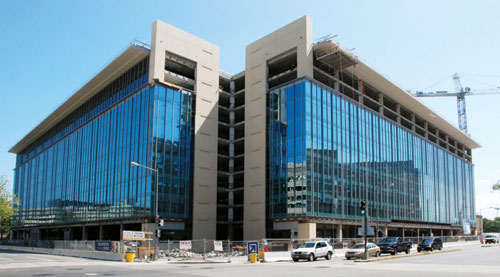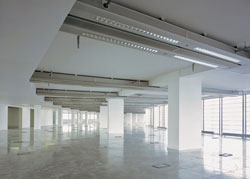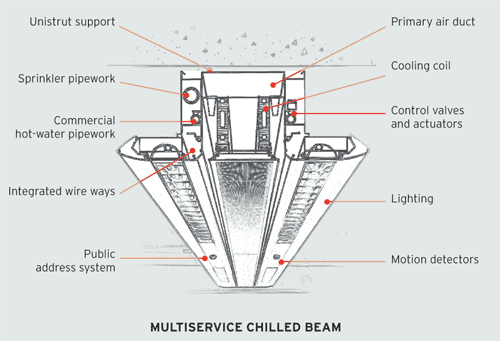An Energy-Conserving Technology From Europe Makes Inroads in the U.S.
American design teams discover the advantages of chilled beams, a mechanical device popular abroad for more than a decade
![]() Continuing Education
Continuing Education
Use the following learning objectives to focus your study while reading this month’s Continuing Education article.
Learning Objectives - After reading this article, you will be able to:
- Discuss how chilled-beam technology works.
- Describe the differences between passive and active chilled beams.
- Explain the benefits of passive chilled beams over conventional cooling systems.
An efficient HVAC technology known as "chilled beam," popular in Europe as well as Australia for more than a decade, is beginning to attract attention in the U.S. The oddly named mechanical device is not a structural beam and is sometimes not even chilled. Resembling a fluorescent light fixture, it is part of a ceiling-mounted system that can provide cooling, heating, and other building services. It uses far less energy than conventional variable air volume (VAV) systems, and some U.S. design teams are adopting it as one strategy toward creating better-performing buildings.
A key difference between chilled beams and conventional systems is that the former deliver cooling via water instead of air. Because water is many times more dense than air, it can provide equivalent cooling energy in a fraction of the volume. And the pumps that move the water require less energy than the fans that move the larger volumes of air. When asked how soon this technology will take off in this country, Donald Haiges, a senior vice president at WSP Flack+Kurtz in Boston says: "It's already begun. There are big benefits in horsepower savings, comfort, and quiet operation."
Passive but effective
The simplest form is known as the "passive chilled beam." Chilled water is piped to a coil, which usually consists of aluminum fins on copper tubing within a perforated metal casing. There, it cools the surrounding air, which drops into the room. Natural convection drives the warmer, more buoyant room air up to the ceiling and into the casing, where it is cooled and naturally drops again. A small space between the top of the chilled beam and the underside of the structure allows the warm air to rise above the beam, turn, and accelerate past the fins of the heat exchanger.
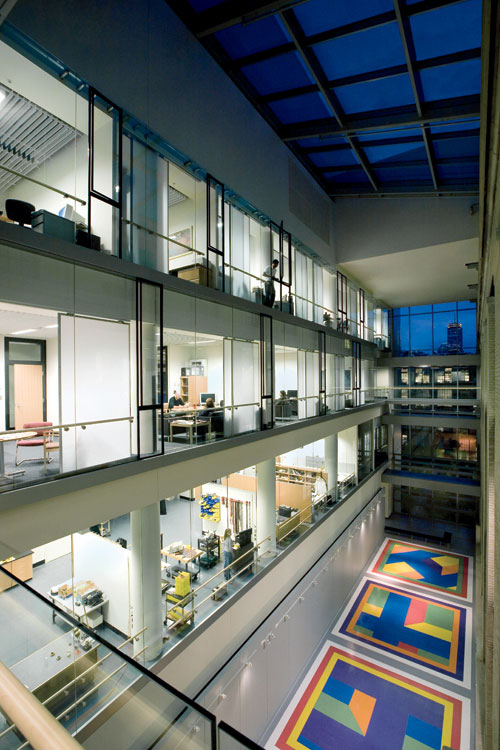 |
For PDSI, a renovation and addition project at the Massachusetts Institute of Technology, Payette Associates chose passive chilled beams to supply cooling to low-occupancy spaces, such as offices. Images © Peter Vanderwarker |
Â
Although the beams provide some degree of cooling by radiation, they differ from conventional radiant-cooling systems, which are often based on walls or floors chilled by embedded cold-water pipes. The latter types of systems cool occupants because heat naturally radiates from a warmer body (a person) to a cooler body (the chilled slab, floor, or other surface). Passive chilled beams, in contrast, must be high in the space because they transfer heat primarily through convection.
Without fans, passive chilled beams are virtually silent. There are no moving parts, so operational costs are lower. To top these advantages, manufacturers claim there is no sacrifice in comfort; indeed, they claim these environments are more comfortable than those served by forced, cooled air.
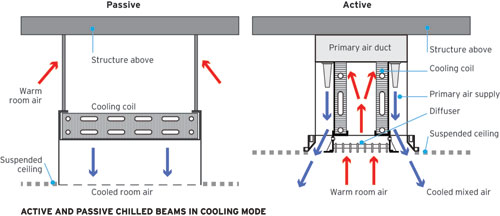 |
Chilled beams are either passive or active. Both types rely on convection for cooling, but active beams are integrated with the primary ventilation air supply. Images courtesy SmithGroup |
Â
Obviously, this method of cooling does not provide any ventilation air, as VAV systems do. So ventilation is required in addition, but ducts can be smaller than usual. In applications where internal loads dominate the cooling needs, the savings on ductwork, air handlers, and fan energy can be substantial. Smaller ducts also mean that architects can design higher ceilings or lower floor-to-floor heights. The resulting savings can more than offset the initial cost of the chilled-beam units.
Because the overall ventilation volume is decreased, ventilation air can contain a higher proportion of outside air, creating a healthier indoor environment. And because there is no central air handler supplying super-cooled air, the wasteful practice of reheat is eliminated.
Chilled beams are typically not visually exposed but are covered by perforated enclosures. The units can be stand-alone, like suspended light fixtures, or they can be integrated with drop-ceiling systems.
To avoid condensation and prevent mold growth, it's important that the temperature of the water delivered to passive chilled beams be at least 2 degrees above the room's dew point, typically between 57 and 60 degrees Fahrenheit. Because this is warmer than conventionally chilled water, a building's central chillers can be smaller and less expensive. Some buildings draw groundwater to supply the beams, and require little, if any, additional water chilling. Chilled beams can be used in very hot, humid climates as long as interior humidity is controlled. This can be accomplished by dehumidifying the ventilation air, although this would then limit the occupants' freedom to open windows for natural ventilation. If the humidity of outdoor air is not a problem, passive chilled beams are compatible with natural ventilation.
There is an art to positioning passive chilled beams to maximize performance and enhance occupant comfort, according to Carl C. Schultz, director of advanced building technologies with URS Corporation, in Columbus, Ohio. They can be placed parallel and adjacent to exterior perimeter walls to counteract the effects of solar gain, he says. "The rising warm air near windows that will naturally come in contact with the cooling element will increase the beam's effectiveness as a heat exchanger," says Schultz. He recommends that passive beams not be placed directly above workstations since the velocity is highest directly below the units. He adds that placing them directly above a heat generator, like a copy machine, reduces the capacity of the beams because the rising warm air counteracts the flow of cool air dropping from the beam. More of Schultz's insights can be found in "Next-Generation Cooling Is Looking Up," in the May 2, 2007, issue of Engineered Systems magazine.
One major hurdle for this technology in the U.S. is the initial cost of the units. Even though they are relatively simple devices, they are expensive because, until recently, they had to be imported, according to Haiges. "When we first investigated chilled beams, contractors weren't sure what they were or how to install them, so they charged a premium," he recalls. "Now that cost is coming down.
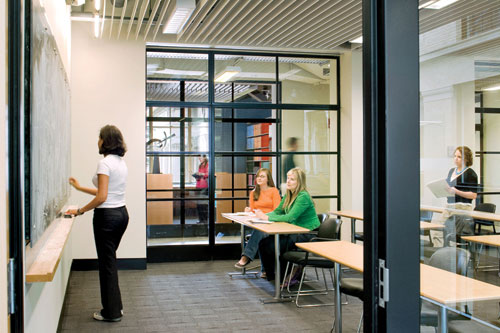 |
|
At MIT's PDSI (above), designers took a Images © Robert Benson (top); courtesy Payette (right) |
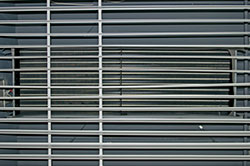 |
Â
Haiges's firm worked with architects from Boston-based Payette to choose passive chilled beams for the low-occupancy spaces in the PDSI (Physics, Department of Material Sciences Engineering, Spectroscopy, and Infrastructure) Project at MIT, in Cambridge, Massachusetts (see page 172). Payette designed 50,000 square feet of new construction in a courtyard between three existing buildings, and renovated another 75,000 square feet to provide direct circulation links between the collaborating departments as well as additional programmatic spaces.
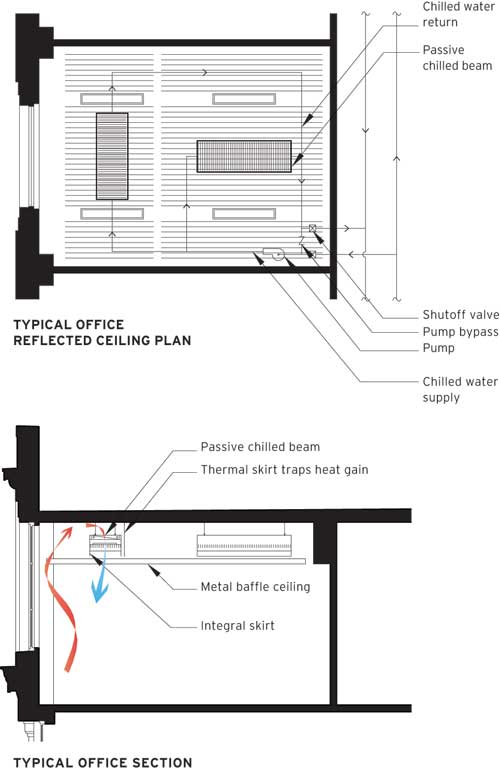 |
Though visually porous, the baffles mask the view of the return-and- supply piping. The "plenum" below the building structure provides ample space for natural convection to occur. Images courtesy Payette |
Â
Rather than conceal the chilled beams with a metal casing or suspended ceiling, the architects took a "no-frills" approach and placed under them a visually porous ceiling of 4-inch high aluminum baffles, 4 inches on center. The "plenum" above gives ample space for natural convection, and the baffles mask the view of the supply-and-return piping. And despite a high first-cost for the beams, the project achieved net savings. "The chilled beams have few moving parts and no associated fan energy, eliminating a lot of ductwork, which meant cost and energy savings," explains Charles Klee, a Payette principal. "And we were able to go to a dedicated outdoor air system where the only air we're moving through the building is what's needed for fresh air, resulting in dramatic energy savings."
Passive versus active
In spaces with higher cooling loads, engineers can choose "active" chilled beams. These are different from their passive cousins, both in mechanical complexity and cooling output. Like passive beams, they depend on natural convection, but they are integrated with the primary ventilation air supply. This centrally conditioned air should be dehumidified, especially in humid climates.
In the operation of active chilled beams, warm room air rises to the ceiling and is drawn into the bottom of the beam by the temperature differential and the inductive effect of the primary air. Inside the beam, the room air is cooled by the coils, mixed with the ventilation air that is introduced at high velocity through nozzles, and discharged into the space through a diffuser. This induction is less noisy than traditional induction units. Active chilled beams require less maintenance than conventional VAV systems because there are fewer moving parts; the coils only need occasional vacuuming. With active beams, the chilled water can be supplied as much as 1.5 degrees below the room's dew point. The continuous airflow reduces the risk of condensation.
Unlike passive beams, active ones combine the cooling mechanism with ventilation air. But in both cases, the need for cooling large volumes of air is eliminated. Higher air velocities give the active beams more cooling potential than passive ones. But because the ventilation air is mixed with the cooled air within the beam before discharging it into the space, the discharge temperature is higher and more uniform than with conventional air-conditioning. Also, according to Haiges, the volume of moving air is 50 to 75 percent lower than with conventional systems. For all these reasons, occupants are less likely to feel drafts.
Optimum spacing of beams throughout a space varies with ceiling height and output capacity. They can be operated singly or grouped for zone control. Although not as silent as passive beams, active chilled beams are quieter than conventional VAV systems. Schultz notes: "Unlike passive beams, active beams can be placed directly over workstations and high convective loads, as these types of beams induce warmer room air up through their center and then disperse the air laterally across the top of the room."
SmithGroup architects and engineers chose active chilled beams for the massive redevelopment of the Constitution Center in Washington, D.C. The 10-story, 1960s-era former Department of Transportation office building was originally designed by Edward Durell Stone. SmithGroup is engaged in a complete overhaul of the entire 1.4-million-square-foot building, which includes replacing Stone's white marble cladding with a glass curtain wall, reinforcing the structure to make it resistant to blasts and progressive collapse, and replacement of mechanical systems.
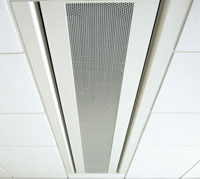 |
SmithGroup chose active chilled beams (left) Images courtesy SmithGroup |
|
|
Â
The chilled beams, installed on typical office floors, are expected to realize the benefits of lower energy consumption, greater occupant comfort, and higher ceilings without replacement of the structure. Said to be the largest U.S. installation to date, the chilled beams can be relocated relatively easily, promising future tenant flexibility. SmithGroup's use of chilled beams is part of its bid for a LEED Core and Shell Silver rating. Designers expect that the building, scheduled for completion in late 2009, will use 23 percent less energy than one compliant with the ASHRAE 90.1 standard.
ACTIVE CHILLED BEAMS IN COOLING AND HEATING MODE |
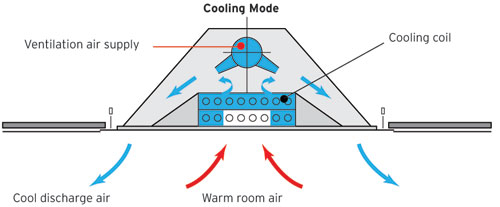 |
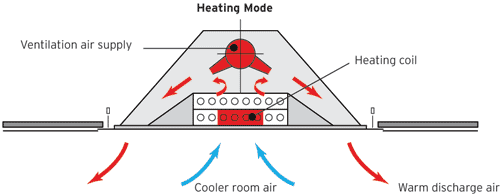 |
Passive chilled beams cannot be used in heating mode since warm air will not naturally drop from the ceiling into a room. However, active chilled-beam units, which are integrated into the building's primary ventilation air system, can provide either heating or cooling, depending on the temperature of the water supplied to the coil. Image courtesy SmithGroup |
Â
"We looked at all the conventional solutions and kept coming back to chilled beam," says Washington, D.C.−based David Varner, a SmithGroup vice president. Selection of the technology permitted engineers to locate mechanical equipment in a rooftop penthouse rather than on each office floor, allowing more rentable space and a more flexible floor plan, he says. Successful tests with full-size mock-ups convinced the owner the system could work in the muggy Washington summer.
"Chilled" heating
Active chilled beams can also be used for heating, further confusing the terminology. The same unit can be used for both heating and cooling, the only difference being the temperature of the supply water. After the air is heated by the water-warmed fan coil, discharge velocity forces it down through the space to the occupants. Warm air won't naturally drop, so passive beams, which depend on convection, are not suitable for heating.
Manufacturers recommend using warm, not hot water. The standard domestic-hot-water temperature makes discharge air too buoyant. Ceiling height is also an important factor when using "chilled" beams for heating: The higher the beam, the lower the hot-water temperature should be.
Often a chilled beam unit works alternately in cooling and heating mode. This is the case for the five-level building planned for the Center for Sciences at California Polytechnic State University in San Luis Obispo, designed by Zimmer Gunsul Frasca Architects, Los Angeles. Offices and classrooms will be tempered with natural ventilation and radiant floors. But this is not feasible in the labs, where operable windows would jeopardize the internal pressurization that keeps contaminants from a possible spill from spreading to other parts of the building.
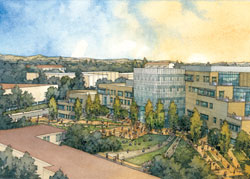 |
|
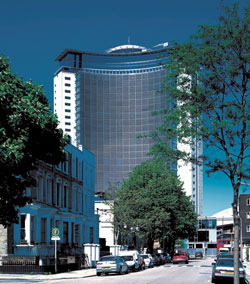 |
A sciences building designed by Zimmer Gunsul Frasca for the California Polytechnic State University (above left) will have naturally ventilated offices and laboratories heated and cooled with active chilled beams. For the conversion of a hotel into the Empress State office building (left and above right), in London, Wilkinson Eyre Architects chose multiservice chilled beams (below), which combine cooling, lighting, and sprinklers, among other features, in an integrated enclosure. Images © Morely Von Sternberg (top right); Edmund Sumner (left); courtesy Trox UK (bottom); Zimmer Gunsul Frasca (top left) |
|
|
Â
The same chilled-beam fan coil is used in both heating and cooling, according to Joseph Wenisch, project manager for Oakland, California−based Rumsey Engineers, ZGF's mechanical consultant. Four pipes run to each lab: chilled-water supply and return and hot-water supply and return. At each lab's entrance, a set of valves switch between hot and cold water. Only two pipes enter the room, with water temperature determined by that room's thermostat. Because each lab is its own zone, one can be heated while another lab in the same building is simultaneously cooled. "In office buildings, it's often not cost-efficient to have a thermostat in every room," Wenisch observes. "But in a lab, there are [already] so many controls, the thermostat isn't a big thing to add."
A compact package
A third category of chilled beam is "multiservice." These units, which can be either passive or active, can also be customized to contain any number of additional building-service systems, including lighting, building management system sensors, information technology cabling, and sprinklers. Understandably, these units are more expensive than the simpler ones, but they offer several advantages. The components can be fitted optimally into the casing so the whole is more compact than the collection of parts would be. Installation scheduling is made easier and potentially more reliable.
The U.K. firms, Wilkinson Eyre Architects and mechanical engineering consultant MG Partnership, chose multiservice chilled beams for the 2003 redevelopment of the 415,000-square-foot Empress State building in West London. Their choice was influenced, in part, by the need to fast-track the conversion of the 1959 hotel into offices. In this case, the integrated services included cooling, ventilation, lighting and associated controls, speakers, and sprinkler distribution. The tower is tricorn-shaped in plan, so the variety of orientations, as well as the low ceiling heights and mix of old and new construction, required a flexible approach.
By concealing the various services within the chilled-beam unit, the architects eliminated suspended ceilings, maximized floor-to-ceiling heights, and reduced ceiling clutter. Prefabrication of the integrated units supported the accelerated construction schedule. The casing was customized to minimize its visual obtrusiveness while accommodating the needed pipes and ducts and optimizing the discharge air-flow pattern. The beams are also designed to ensure tenant flexibility. Each has its own control valve. In the future, adding a sensor and wiring back to the floor outstation can provide any new zone with individual comfort control.
With all the benefits of chilled beams, which have proved effective for nearly two decades in other parts of the world, some engineers predict that it's only a matter of time before they come into widespread acceptance in the U.S. "I have become a convert of what I envision as perhaps the next big HVAC trend, which is to minimize both fan and reheat energy," says Schultz. "What VAV systems were to the past three decades, chilled beams or similar concepts could be to the next three."

